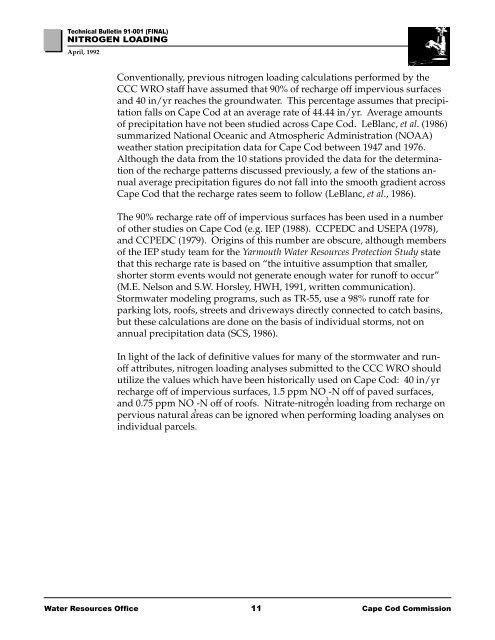Technical Bulletin 91-001 Nitrogen Loading - Cape Cod Commission
Technical Bulletin 91-001 Nitrogen Loading - Cape Cod Commission
Technical Bulletin 91-001 Nitrogen Loading - Cape Cod Commission
You also want an ePaper? Increase the reach of your titles
YUMPU automatically turns print PDFs into web optimized ePapers that Google loves.
<strong>Technical</strong> <strong>Bulletin</strong> <strong>91</strong>-<strong>001</strong> (FINAL)<br />
NITROGEN LOADING<br />
April, 1992<br />
Conventionally, previous nitrogen loading calculations performed by the<br />
CCC WRO staff have assumed that 90% of recharge off impervious surfaces<br />
and 40 in/yr reaches the groundwater. This percentage assumes that precipitation<br />
falls on <strong>Cape</strong> <strong>Cod</strong> at an average rate of 44.44 in/yr. Average amounts<br />
of precipitation have not been studied across <strong>Cape</strong> <strong>Cod</strong>. LeBlanc, et al. (1986)<br />
summarized National Oceanic and Atmospheric Administration (NOAA)<br />
weather station precipitation data for <strong>Cape</strong> <strong>Cod</strong> between 1947 and 1976.<br />
Although the data from the 10 stations provided the data for the determination<br />
of the recharge patterns discussed previously, a few of the stations annual<br />
average precipitation figures do not fall into the smooth gradient across<br />
<strong>Cape</strong> <strong>Cod</strong> that the recharge rates seem to follow (LeBlanc, et al., 1986).<br />
The 90% recharge rate off of impervious surfaces has been used in a number<br />
of other studies on <strong>Cape</strong> <strong>Cod</strong> (e.g. IEP (1988). CCPEDC and USEPA (1978),<br />
and CCPEDC (1979). Origins of this number are obscure, although members<br />
of the IEP study team for the Yarmouth Water Resources Protection Study state<br />
that this recharge rate is based on “the intuitive assumption that smaller,<br />
shorter storm events would not generate enough water for runoff to occur”<br />
(M.E. Nelson and S.W. Horsley, HWH, 19<strong>91</strong>, written communication).<br />
Stormwater modeling programs, such as TR-55, use a 98% runoff rate for<br />
parking lots, roofs, streets and driveways directly connected to catch basins,<br />
but these calculations are done on the basis of individual storms, not on<br />
annual precipitation data (SCS, 1986).<br />
In light of the lack of definitive values for many of the stormwater and runoff<br />
attributes, nitrogen loading analyses submitted to the CCC WRO should<br />
utilize the values which have been historically used on <strong>Cape</strong> <strong>Cod</strong>: 40 in/yr<br />
recharge off of impervious surfaces, 1.5 ppm NO -N off of paved surfaces,<br />
3<br />
and 0.75 ppm NO -N off of roofs. Nitrate-nitrogen loading from recharge on<br />
3<br />
pervious natural areas can be ignored when performing loading analyses on<br />
individual parcels.<br />
Water Resources Office 11<br />
<strong>Cape</strong> <strong>Cod</strong> <strong>Commission</strong>
















